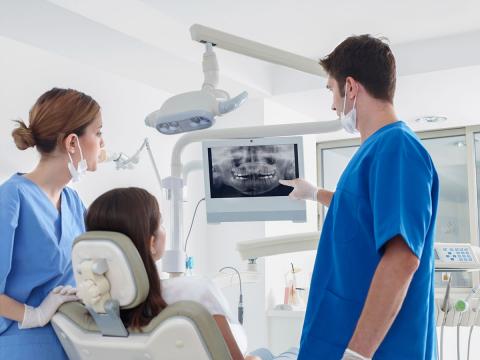Dental radiography - taking x-rays of the mouth and the teeth - helps your dentist have a full picture of what is happening with your teeth. An x-ray will give your dentist a lot of information which a visual examination cannot provide. Radiography allows...
- viewing the extent of decay (caries) within a tooth
- seeing teeth that have not appeared above the gum line yet (particularly wisdom teeth)
- seeing what is happening inside a tooth
- looking between two teeth that are very close together
- visualising the tooth root properly (before a tooth extraction)
- inspecting the bone (the jawbone) underlying the teeth
- getting a clear view of any abscesses or cysts that might be present
Radiography Methods
There are a range of different methods of taking x-ray images (the images themselves are called 'radiographs') and at Caboolture Dental Group we have the latest radiography imaging equipment so we can give you the best dental care. Here are some of the types of x-ray methods that we use...
Bitewing radiographs
As the name implies, a small plastic 'wing' which you bite down on, is put into the mouth around a particular tooth or set of teeth, and the radiograph image reveals any decay between the teeth, and in some cases is used to assess the bone underneath the tooth. Bitewing radiographs are used generally on the back teeth.
Periapical radiographs
These types of radiograph take an image of an entire tooth as well as the bone around the tooth and are used with front and back teeth. Periapical ('peri' means 'around' in Greek) radiographs are used particularly before root canal therapy to assess if it is needed and to check the affected tooth or teeth afterwards.
Panoramic radiography
A special type of x-ray machine called an OPG (OrthPantomoGraph) machine is used to take a panoramic x-ray of the upper and lower jaw. This type of x-ray is most commonly used to view wisdom teeth to check if they are impacted and to review any damage to the jaw, although it is very useful in identifying a range of conditions that affect the mouth and the teeth. The patient bites on a piece of plastic so that an x-ray image of every tooth is captured. The process takes about a minute.
Cone beam computed tomography (CBCT)
While conventional dental x-ray machines capture two dimensional images of teeth and underlying bone, only more modern CBCT machines can capture three dimensional images. The benefits of using CBCT over conventional x-rays is that one scan, which generally takes no longer than 40 seconds, captures enough information for many different 3D views to be compiled, from an overall view to a detailed view of a particular tooth.
Radiography and radiation
All radiography, including dental radiography, involves the use of radiation. However, advance in radiography technology means that the radiation dose you receive from a dental x-ray is about the equivalent of the radiation you are exposed to in short airline flight (say from Brisbane to Sydney). New techniques using digital radiography are also reducing the amount of radiation needed to produce clear and accurate images.
